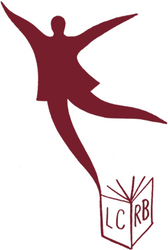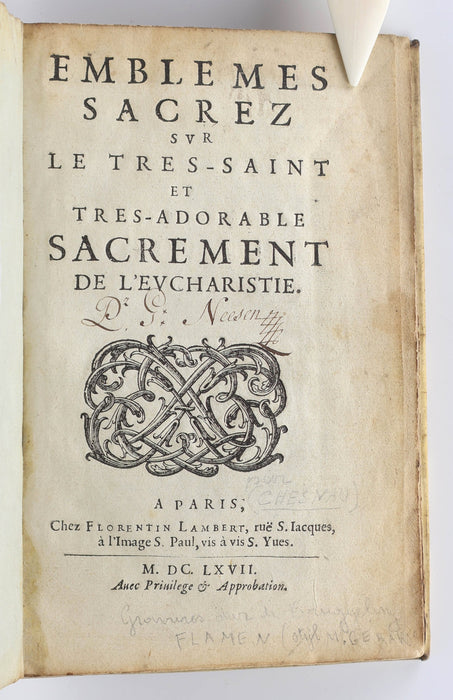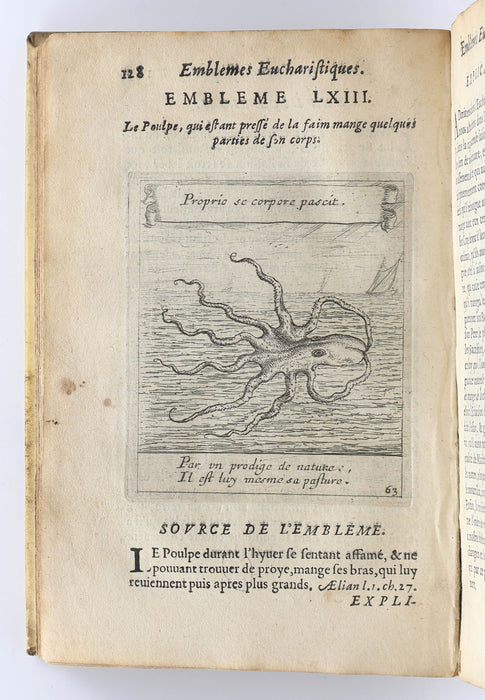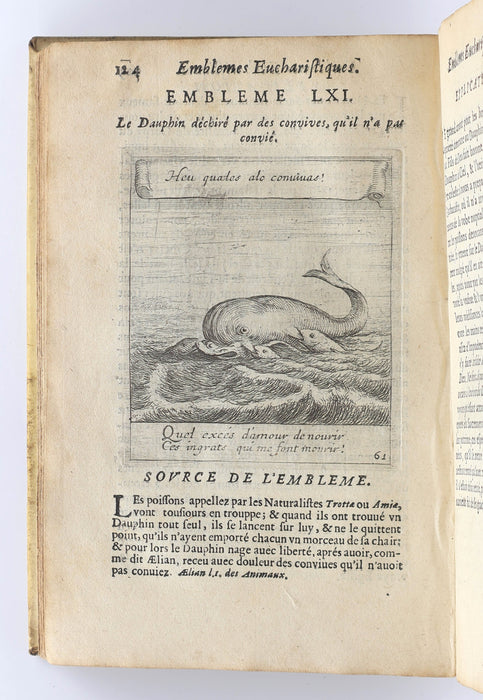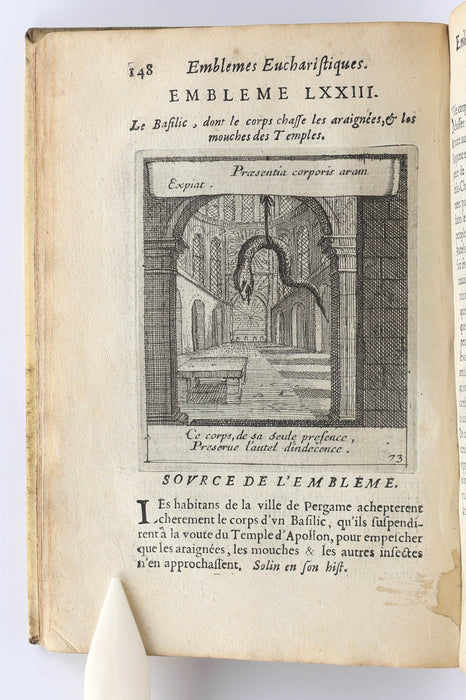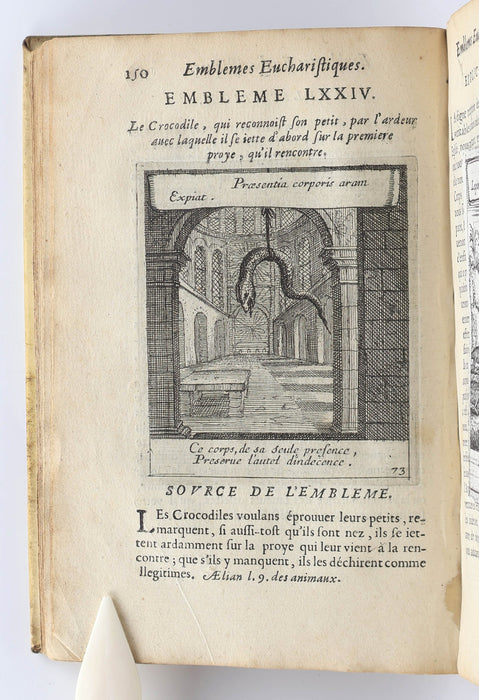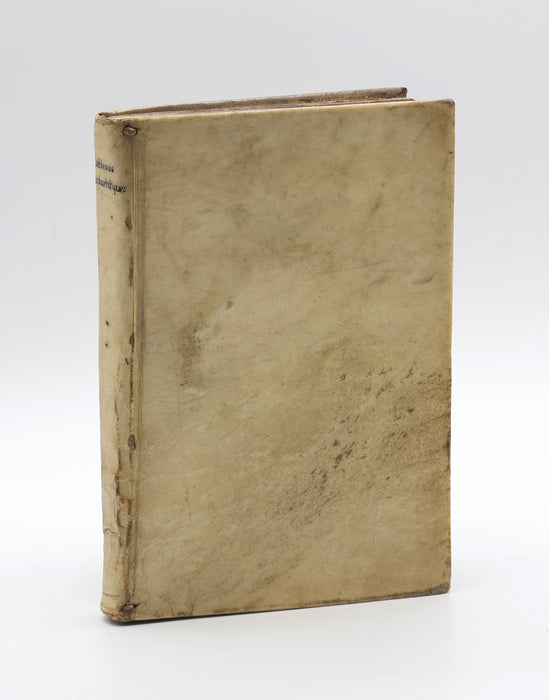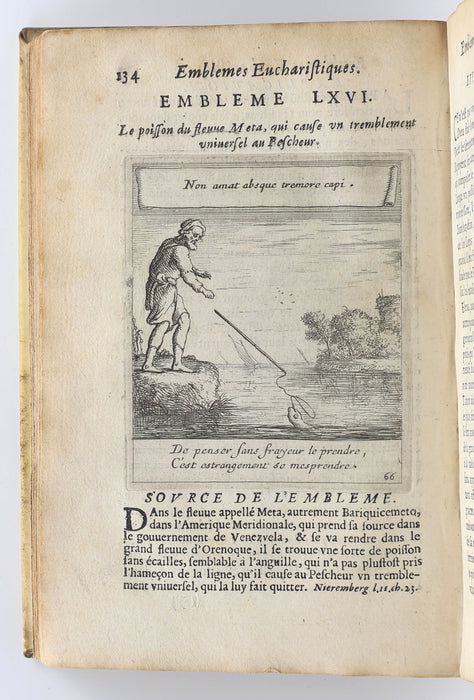
NEW WORLD ANIMALS
[Chesneau, Augustin, O.E.S.A.] [Flamen, Albert]: Emblemes sacrez sur le tres-saint et tres-adorable Sacrement de l’Eucharistie. A Paris, chez Florentin Lambert, ruë S. Iacques, à l’Image S. Paul, vis à vis S. Yues. 1667.
Copy (with unusual printing errors) of the first French-language edition of Orpheus eucharisticus, sive Deus absconditus (1657), an emblem book on the Eucharist. The second edition of the text overall, this text was abridged and translated from the Latin by Augustin Lubin. The 101 emblems were produced by Albert Flamen (c.1620–after 1693), a Flemish engraver working in France, perhaps the ‘A. Flament’ noted as ‘peintre et dessinateur ordinaire de Monsieur, Frère du Roy’ in 1692 (Coppens 2003).
The emblems depict a variety of subjects from both the human and the natural world. Emblem 30 depicts the Pauxis, with a precious blue stone in its nose, which was understood to have been brought from America to Philip II of Spain. Emblem 66 shows an electric eel found in the Meta River (a tributary of the Orinoco) - giving a fisherman a jolt.
In the present copy, plate 73 appears a second time where plate 74 should be, and plates 99 and 100 are in the wrong order. A modern reader has enclosed a printout of the missing plate 74. Plate 74 appears correctly in both the Getty Institute copy and the Universitätsbibliothek Kiel copy (both digitized; see bibliography). Further, in both the Getty and Kiel copies, plates 99 and 100 are in the correct order.
In books like Emblemes sacrez, in which letterpress text and intaglio prints appear on the same sheet, word and image would have been added in two separate phases (cf. Gaskell 2004, p. 229). Specifically, all of the text would have been printed first, with blank spaces left for the intaglio prints to be added later (cf. Gaskell 2004, p. 229).
Adding 101 intaglio prints to each copy of Emblemes sacrez would have been a complex undertaking. Presumably copies would have been processed in batches, with the intaglio prints added in parallel (i.e. all plate 1s, then all plate 2s, etc.). The potential for error here, especially given that the majority of the plates are the same size, would have been high—and, in this copy, something did indeed go wrong.
More research would be needed to establish how exactly these errors occurred in practice, and how many other surviving copies preserve the same mistakes. What is clear, however, is that the present copy provides a valuable insight into human error in early printing.
Details
Printed. 1 volume, 17.9 cms x 12 cms in binding, octavo, pp. [12] 205 [1]. Several pages misnumbered. Woodcut device to title-page, further woodcut decoration, 101 engraved plates numbered [1], 100. Plate 73 printed twice, the second time instead of plate 74 (see above). Plates 99 and 100 printed in wrong order.
Bound in contemporary or early vellum. Lettering to spine (Emblemes Eucharistiques), with remnants of earlier lettering underneath. Pastedowns at front and rear, one free endpaper at front and one at rear.
Condition (textblock): browning, some foxing, spotting, and staining. Loosening to textblock. Condition (binding): Vellum slightly soiled and scratched, two very small holes in spine, pastedowns broken around vellum turn-ins.
Provenance:
- Owner’s inscription on title page (Pr G Neesen).
- Remnants of a bookplate on front pastedown but no text remaining.
- Modern paper print-out of plate 74 enclosed between pp. 150–51 (9.3 cms x 8 cms). Dutch explanatory note in red pen on reverse (Deze plaat [--?--] in alle ex. van deze editie misdrukt).
- Modern pencil notes on front free endpaper and title page.
Bibliography:
OCLC shows copies outside mainland Europe at University of Glasgow, Ushaw College, McMaster University, Columbia University, Duke University, Getty Research Institute, Harvard University, the Huntington Library, Newberry Library, Princeton University, and Yale University. We have previously sold a copy to one further American institution.
Coppens, Christian, ‘Flamen, Albert’, Grove Art Online (2003). Last accessed 20 May 2021.
Gaskell, Roger, Printing House and Engraving Shop: A Mysterious Collaboration, The Book Collector 53 (2004), pp. 213–54. Last accessed 20 May 2021 via www.rogergaskell.com.
‘Flamen, Albert’, RKD Nederlands Instituut voor Kunstgeschiedenis. Last accessed 20 May 2021 at https//rkd.nl/nl/explore/artists/28215.
Digitization of Getty Digital Institute copy of Emblemes sacrez (1667). Last accessed 20 May 2021 via www.archive.org.
Digitization of Universitätsbibliothek Kiel copy of Emblemes sacrez (1667). Last accessed 20 May 2021 via https://dibiki.ub.uni-kiel.de/viewer/resolver?urn=urn:nbn:de:gbv:8:2-1019674.
Hopel, Ingrid, ‘Augustin Chesneau's Emblemes Sacrez of 1667: Nature Study and Last Supper’, Emblematica 16 (2008), pp. 321–38. [Currently unable to access].
Landwehr, John, French, Italian, Spanish, and Portuguese Books of Devices and Emblems 1534–1827: A Bibliography. Bibliotheca Emblematica VI, Romanic Emblem Books (Utrecht: Haentjens, Dekker & Gumbert 1976), p. 225.
